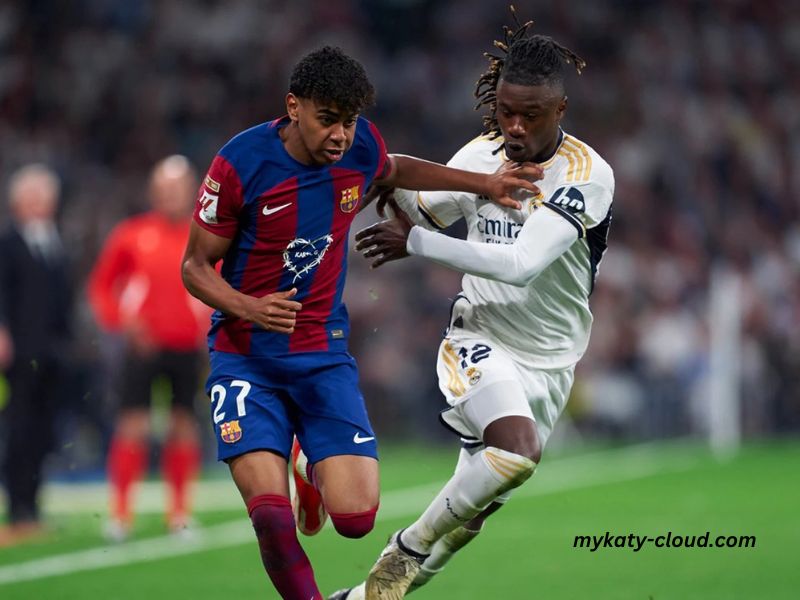The El Clásico match between Real Madrid and FC Barcelona is one of the most anticipated and intense fixtures in global football. It is a contest that has transcended the sport, becoming a symbol of rivalry, passion, and historical significance. Each encounter between these two giants of Spanish football is more than just a game; it is a battle for supremacy, both on and off the pitch, with every match contributing to the rich history of the rivalry.
At the heart of these encounters are the alineaciones (lineups) of both teams. These starting formations play a crucial role in determining the outcome of the match, as the strategic decisions made by the coaches can shift the balance in favor of one team or another. In this article, we will explore the various lineups of Real Madrid against FC Barcelona, focusing on key moments from their historic meetings and how these formations have evolved over time.
The Evolution of Real Madrid’s Alineaciones in El FC Barcelona
Real Madrid, one of the most successful clubs in the world, has had an array of world-class players who have graced the pitch in El Clásico. From the era of Alfredo Di Stéfano in the 1950s to the current stars such as Karim Benzema and Vinícius Júnior, the team’s lineup has always been filled with talent and star power.
1. The Di Stéfano Era: 1950s-1960s
In the 1950s, Real Madrid’s lineup was synonymous with dominance. With figures like Alfredo Di Stéfano, Francisco Gento, and Ferenc Puskás, the team was a force to be reckoned with. Real Madrid’s alineación in these years focused on fast-paced attacking football, and their ability to overwhelm opponents, including FC Barcelona, was unmatched.
Di Stéfano, often playing as an attacking midfielder or a forward, was at the heart of Madrid’s strategies. His versatility and intelligence on the ball made him a key figure in every El Clásico. The 1960s saw Madrid’s dominance in European football, with the club securing several European Cups during this period. Real Madrid’s lineup, including players like Gento and Puskás, made the El Clásico matchups legendary.
2. The Galácticos Era: Early 2000s
Fast forward to the early 2000s, and Real Madrid was home to some of the biggest names in world football. The “Galácticos” era, spearheaded by President Florentino Pérez, saw players like Zinedine Zidane, David Beckham, Luis Figo, and Ronaldo Nazário gracing the pitch. These players were joined by established stars such as Raúl González and Roberto Carlos, creating a dream lineup that took on FC Barcelona in the fiercest of El Clásicos.
The 2002-2003 El Clásico was a memorable one, with Real Madrid’s lineup boasting an attacking prowess few teams could match. The presence of Zidane in midfield and Ronaldo in attack made the team a powerhouse. The 4-3 victory in that particular match was a showcase of the attacking football that defined the era. The alineaciones of this period were focused on creativity, flair, and a free-flowing attacking style, making them a nightmare for opponents.
3. The Post-Galácticos and Counter-Attacking Football: 2010s
After the decline of the Galácticos era, Real Madrid’s approach to El Clásico changed. Under the guidance of managers like José Mourinho and Carlo Ancelotti, the team adopted a more pragmatic approach, focusing on counter-attacking football and solid defensive organization. Players like Cristiano Ronaldo, Sergio Ramos, and Luka Modrić became central figures in the team’s alineación.
The 2010s were defined by intense El Clásico matches, with the rivalry between Cristiano Ronaldo and Lionel Messi at its peak. The tactical approach of Mourinho’s Real Madrid, built around quick transitions and clinical finishing, was evident in their 2-1 victory in the 2012 Copa del Rey final, a match in which Cristiano Ronaldo scored a header that would go down in history.
During this period, the alineaciones were often geared toward stifling FC Barcelona possession-based game. Real Madrid’s defense, led by Sergio Ramos and Pepe, was designed to frustrate Messi and his teammates, while midfielders like Modrić and Toni Kroos provided the creativity necessary for swift counter-attacks.
Key Moments and Tactical Shifts in El Clásico Lineups
The alineación in El Clásico isn’t just about star names; it also reflects the tactical battle between the coaches. Over the years, different managers have approached this fixture in unique ways, making strategic decisions that have had a lasting impact on the outcomes of matches.
1. The Pep Guardiola vs. José Mourinho Rivalry: 2010-2013
During the early 2010s, the rivalry between Pep Guardiola (FC Barcelona) and José Mourinho (Real Madrid) became the focal point of El Clásico. Guardiola’s Barcelona was built around possession, pressing, and fluid attacking play, while Mourinho’s Real Madrid focused on defensive solidity and counter-attacking brilliance.
In their respective lineups, Guardiola employed the likes of Sergio Busquets, Xavi Hernández, and Andrés Iniesta to dominate possession, while Mourinho relied on the speed and finishing ability of players like Cristiano Ronaldo, Gonzalo Higuaín, and Ángel Di María. The alineación under Mourinho often included a defensive midfielder like Xabi Alonso, whose role was pivotal in breaking up FC Barcelona attacks and distributing quick passes forward.
The 2011 Copa del Rey final is one of the most memorable matches of this period. Real Madrid’s lineup, featuring a solid defensive structure and fast wingers, triumphed 1-0 over Barcelona, with Cristiano Ronaldo scoring the match-winning goal. It was a tactical masterstroke by Mourinho, with his alineación disrupting Barcelona’s possession game.
2. The Arrival of Zinedine Zidane and the Shift to Possession Football: 2016-2020
When Zinedine Zidane took over as manager in 2016, Real Madrid’s alineación underwent a slight transformation. While Zidane maintained the defensive solidity that was a hallmark of Mourinho’s era, he introduced a more possession-based approach, with Casemiro, Modrić, and Toni Kroos providing a dynamic midfield.
Under Zidane, Real Madrid’s counter-attacks were more nuanced, and the team became more clinical in front of goal. Players like Karim Benzema, Cristiano Ronaldo, and Gareth Bale formed a formidable attacking trio, capable of dismantling FC Barcelona defense. The 2017 El Clásico at the Santiago Bernabéu saw Zidane’s side dominate possession and win 2-1, with Cristiano Ronaldo scoring twice.
FC Barcelona Alineación Against Real Madrid
Over the years, Barcelona has also evolved its alineación in response to Real Madrid’s strength and tactical shifts. Under managers like Frank Rijkaard, Pep Guardiola, Luis Enrique, and Ernesto Valverde, Barcelona has consistently played an attractive and attacking brand of football, with a focus on possession and pressing.
1. Guardiola’s Barcelona: 2008-2012
Under Pep Guardiola, Barcelona’s lineup was the epitome of tiki-taka, a possession-based style that wore down opponents with quick, short passes. Key players like Xavi Hernández, Andrés Iniesta, and Lionel Messi were central to this system. In El Clásico, Barcelona’s alineación often included Sergio Busquets as the holding midfielder, allowing Xavi and Iniesta the freedom to dictate the tempo of the game.
The 5-0 victory over Real Madrid in 2010 is perhaps the greatest example of Barcelona’s dominance in El Clásico during this period. In that match, Barcelona’s alineación was fluid and dynamic, with Messi in brilliant form, scoring a hat-trick and making a mockery of Madrid’s defense.
2. Luis Enrique’s FC Barcelona: 2014-2017
The next key period for Barcelona came under Luis Enrique, whose alineación included a front three of Lionel Messi, Luis Suárez, and Neymar—the famed “MSN” trio. This attacking force made Barcelona a feared team in El Clásico, as seen in the 2017 encounter, where they won 3-2 at the Santiago Bernabéu, with a dramatic last-minute goal from Luis Suárez.
Conclusion
The alineaciones de Real Madrid contra FC Barcelona have evolved over time, with both teams adapting their tactics and lineups to gain the upper hand in this iconic rivalry. From the early dominance of Di Stéfano’s Real Madrid to the modern-day clashes between Karim Benzema and Robert Lewandowski, El Clásico has always been a showcase of world-class talent and strategic brilliance.
The lineups of these matches are not just about the players; they reflect the broader philosophies and tactics of each manager. As we look ahead to future El Clásicos, the importance of the




